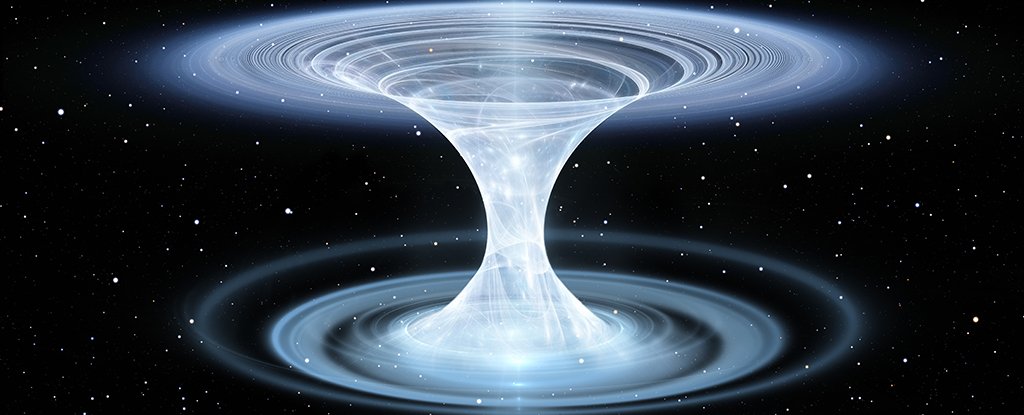Interview with an Astrophysicist
 |
| Model of a Wormhole |
 |
| Dr. John "Jack" Hewitt |
- Clarify how wormholes work.
- Why do you move slower through time when approaching the speed of light?
- I know that we can’t travel at light speed, but what is the fastest speed that we can travel that isn’t light speed?
- Is there any other theoretical way to travel to the past other than something crazy like black holes?
- What do you know about black holes?
- Do you know anything about paradoxes?
Before our meeting, we also sent Dr. Hewitt Isaias's explanation of a wormhole:
Wormholes (as the name suggests) are “holes” that theoretically may appear as rips or tears in spacetime. How you may ask? Well imagine the “spacetime” as a cloth. A wormhole appears when the cloth that is spacetime becomes “bent,” and a “hole” of sorts is ripped in between the two sides of the cloth of spacetime. The “hole” that has been made can be travelled through, allowing a not faster, but more time efficient form of travel than light speed. The reason this form of travel IS more time efficient is because you would travel a longer distance (say a couple thousand miles) in a shorter time span then going at light speed the normal way. Essentially, a wormhole is a “backdoor” or “shortcut” through rips in space connecting it by making spacetime bend and connect together.
My friend, Paul, had already taken a look at the explanation and offered this feedback, which we also discussed with Dr. Hewitt, who was able to expand on it:
| Mmmm - Spacetime looks delicious! |
Otherwise, this is pretty accurate. The reason wormholes can be used as shortcuts is that the distance along them can be shorter than the distance between the two ends if you go the "usual" way.
Paul sent us this video simulation of a wormhole, which we watched with Dr. Hewitt:
Watching this video and discussing it and Isaias's wormhole explanation with Dr. Hewitt helped to nuance Isaias's thinking around wormholes and the question of time travel that lead us to study wormholes in the first place. In a follow-up discussion, Isaias noted that, "it shows us that there ARE theoretically more ways other than black holes to time travel to the past."
I took the following notes from their conversation:
I took the following notes from their conversation:
- Point mass - a massive particle that exists in point; a point with negative mass
- Gravity only on the smallest quantum scales
- Pulling things into a well, and negative pressure pushes it around to form the “donut”
- Ant can’t see the curvature of the donut, like we can’t see the curvature of the Earth
- Math of Einstein’s theories not too complex
- In Einstein’s theory, we can treat light as a wave rather than a particle
- You have to think in the world of science fiction. You have to be kind of open. Try to visualize them.
- When stuff falls into a black hole it gets stretched - "Spaghettification"
- Like a tube of toothpaste - as things in the black hole get squeezed, it gets thrown out in jets
- Some particles get heated up so much that they shoot away, approaching the speed of light (cosmic rays)
- These particles are usually unstable, but because they are traveling at near the speed of light, their internal clock slows way down (they are time traveling)
- Same thing happens in a gamma ray burst in new black stars
- Quasars?
- Matter that crashes together and creates light that gets shot toward us
- Hawking radiation - some particles fall in and some fall out
- These are actual particles
- If you could travel faster than the speed of light, you would go back in time.
- Tachyons - theoretical particles that always travel at the speed of light (no acceleration because they have always been going at that speed)
- We don’t know why time exists and has a direction - there are some theories...
- We think through electromagnetic processes. Those processes would remain constant even at this speed.
- Dark energy relates to wormholes. A wormhole has some anti-mass that creates some anti-gravity.
- Space is four-dimensional - time is the fourth dimension
- As particles get closer to the speed of light, they slow down.
- Once a wormhole is created, that is an event in time that breaks off a piece of the universe. This is a paradox in itself. (pocket dimension inside the wormhole)
- We don’t know of anything that could create a wormhole, except maybe dark energy?
- Get a good understanding of math in general but start trying to think of things like black holes in mathematical terms.
- The thing you need to do as a scientist is to think, how can I prove or disprove this?
Many of these thoughts, particularly those highlighted in yellow, will be used in the production of our final product, a video arguing that time travel to the past, as presented in the book Opposite of Always, by Justin A. Reynolds, is not scientifically viable.


Comments
Post a Comment